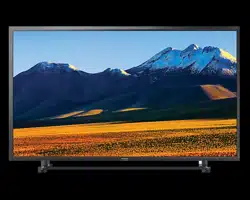Documents: Go to download!
User Manual
- Owner's manual - (English, French)
- e-Manual - (English)
- e-Manual - (English)
- e-Manual - (English)
USER MANUAL Tv
Quick Guides
You can learn quickly how to run and use the frequently used functions, such as Bixby, Ambient Mode, and Smart Hub.
Connecting the Samsung Smart Remote to the TV
Connect the Samsung Smart Remote to your TV to operate the TV.
When you turn on the TV for the first time, the Samsung Smart Remote pairs to the TV automatically. If the Samsung Smart Remote does not pair to the TV automatically, point it at the front of the TV, and then press and hold the  and
and  buttons simultaneously for 3 seconds or more.
buttons simultaneously for 3 seconds or more.
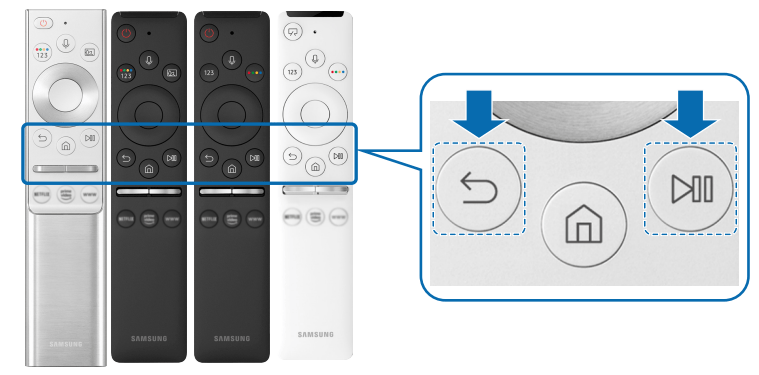
The images, buttons, and functions of the Samsung Smart Remote may differ with the model or geographical area.
For more information about the Samsung Smart Remote that comes with the QLED TV (except for Q50R model) and The Serif, refer to "About the Samsung Smart Remote (QLED TV and The Serif)."
For more information about the Samsung Smart Remote that comes with the UHD TV and Q50R model, refer to “About the Samsung Smart Remote (UHD TV and Q50R model).”
For more information about the Samsung Smart Remote that comes with The Frame, refer to “About the Samsung Smart Remote (The Frame).”
The Samsung Smart Remote may not be supported depending on the model or geographical area.
Using Smart Hub
Connect to Smart Hub for apps, games, movies, and more.
Enjoy the multiple functions provided by Smart Hub simultaneously on a single screen.
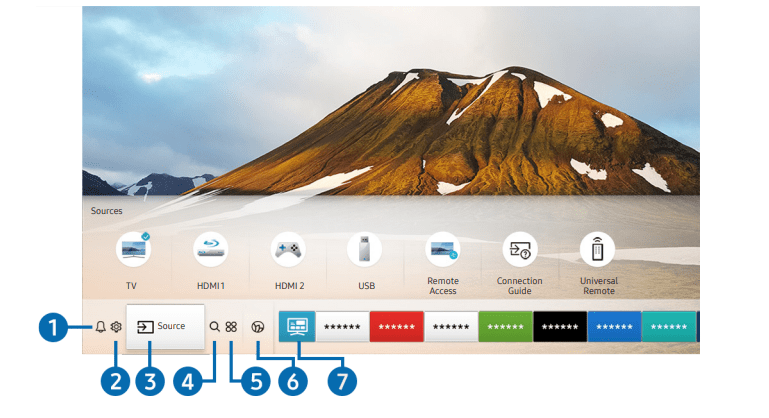
The image on your TV may differ from the image above depending on the model and geographical area.
When you press the  button on your remote control, you can use the following functions and features.
button on your remote control, you can use the following functions and features.
1.  Notification: You can view a list of notifications for all events that occur on your TV. A notification appears on the screen when it is time to broadcast a scheduled program or when an event occurs on a registered device. " For more information, refer to "Displaying the Home Screen."
Notification: You can view a list of notifications for all events that occur on your TV. A notification appears on the screen when it is time to broadcast a scheduled program or when an event occurs on a registered device. " For more information, refer to "Displaying the Home Screen."
2.  Settings: When the focus is moved to Settings, a list of quick settings icons appears above the top of the menu. You can quickly set frequently used functions by clicking the icons.
Settings: When the focus is moved to Settings, a list of quick settings icons appears above the top of the menu. You can quickly set frequently used functions by clicking the icons.
3.  Source: You can select an external device connected to the TV. " For more information, refer to "Switching between external devices connected to the TV."
Source: You can select an external device connected to the TV. " For more information, refer to "Switching between external devices connected to the TV."
4.  Search: You can search for channels, programs, movie titles, and apps from Smart Hub. " To use this feature, the TV must be connected to the Internet.
Search: You can search for channels, programs, movie titles, and apps from Smart Hub. " To use this feature, the TV must be connected to the Internet.
5.  APPS: You can enjoy a wide range of content including news, sports, weather, and games by installing the corresponding apps on your TV. " To use this feature, the TV must be connected to the Internet. " For more information, refer to "Using the APPS Service."
APPS: You can enjoy a wide range of content including news, sports, weather, and games by installing the corresponding apps on your TV. " To use this feature, the TV must be connected to the Internet. " For more information, refer to "Using the APPS Service."
6.  Ambient Mode: You can enhance your living space with decorative content that matches the surroundings or view essential real-time information such as weather, time, and news on the TV screen when you are not watching TV. To enter Ambient Mode, press the
Ambient Mode: You can enhance your living space with decorative content that matches the surroundings or view essential real-time information such as weather, time, and news on the TV screen when you are not watching TV. To enter Ambient Mode, press the  button. To return to the TV mode, press the
button. To return to the TV mode, press the  button. To shut off the TV, press the
button. To shut off the TV, press the  button. If you press the
button. If you press the  button when the TV is turned off, the TV turns on in Ambient Mode.
button when the TV is turned off, the TV turns on in Ambient Mode.
- If you use a remote control other than the Samsung Smart Remote, there may be restrictions to entering Ambient Mode.
- Because this function is specific to QLED TV (except for Q50R model) and The Serif, it may not be supported depending on the model.
- For more information about the Ambient Mode, refer to "Using the Ambient Mode."
7.  Universal Guide: Universal Guide is an app that allows you to search for and enjoy various content such as TV shows, dramas, and movies in one place. Universal Guide can recommend content tailored to your preferences.
Universal Guide: Universal Guide is an app that allows you to search for and enjoy various content such as TV shows, dramas, and movies in one place. Universal Guide can recommend content tailored to your preferences.
- For more information about Universal Guide, refer to “Using the Universal Guide App.”
- Images may look blurry depending on the service provider's circumstances. "
- This function may not be supported depending on the model or geographical area.
 Art: When you are not watching TV or when the TV is turned off, you can use the Art mode function to edit image content such as artworks or photos or to display the content.
Art: When you are not watching TV or when the TV is turned off, you can use the Art mode function to edit image content such as artworks or photos or to display the content.
- This function is supported only in The Frame.
- For more information, refer to the provided user manual.
Getting Support
Get help directly from Samsung if you have a problem with your TV.
Getting support through Remote Management
 ->
->  Settings -> Support -> Remote Management Try Now
Settings -> Support -> Remote Management Try Now- After consenting to our service agreement, you can use Remote Management to access Remote Support and have a Samsung service technician diagnose your TV, correct problems, and update your TV's software remotely via the web. You can also turn Remote Management on and off. You can also start this function by pressing and holding
 the button for 5 or more seconds.
the button for 5 or more seconds.- This function requires an Internet connection.
Finding the contact information for service
 ->
->  Settings -> Support -> About TV Try Now
Settings -> Support -> About TV Try Now- You can view the address of the Samsung website, the call center phone number, your TV's model number, your TV's software version, Open Source License and other information you may need to get service support from a Samsung call agent or the Samsung website.
- You can also view information by scanning the QR code of your TV.
- You can also start this function by pressing and holding the
 button for 5 or more seconds. For the standard remote control, press and hold the
button for 5 or more seconds. For the standard remote control, press and hold the  (Play) button for 5 or more seconds. Continue holding the button until the customer information pop-up window appears.
(Play) button for 5 or more seconds. Continue holding the button until the customer information pop-up window appears.
Requesting service
 ->
->  Settings -> Support -> Device Care -> Request Support Try Now
Settings -> Support -> Device Care -> Request Support Try Now- You can request service when you encounter a problem with the TV. Select the item matching the problem that you encountered, enter the required item, move the focus to Next, and then press the Select button. Select Request Now -> Send or Schedule Appointment -> Request -> Send. Your service request will be registered. The Samsung Contact Center will contact you to set up or confirm your service appointment. You must agree to the terms and conditions for the service request. This function may not be supported depending on the geographical area. This function requires an Internet connection.
Connections
You can watch live broadcasts by connecting an antenna and antenna cable to your TV and can get access to the Internet by using a LAN cable or wireless access point. Using various connectors, you can also connect external devices.
Connection Guide
You can view detailed information about external devices that can be connected to the TV.
 →
→  Source → Connection Guide Try Now
Source → Connection Guide Try Now
It shows you how to connect various external devices such as video devices, game consoles, and PCs using pictures. If you select the connection method and an external device, the connection details appear.
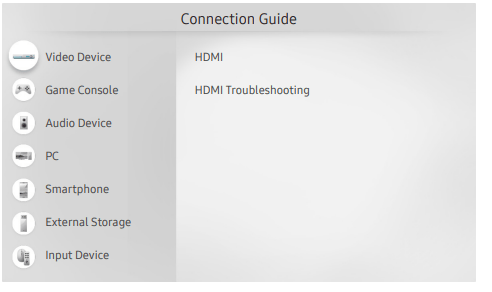
The image on your TV may differ from the image above depending on the model and geographical area.
Connecting an Antenna
You can connect an antenna cable to your TV.
An antenna connection is not necessary if you connect a cable box or satellite box

Connecting to the Internet
- You can get access to the Internet through your TV.
 ->
-> Settings -> General -> Network -> Open Network Settings
Settings -> General -> Network -> Open Network Settings 
- Configue network settings to connect to an available network.
Establishing a wired Internet connection: . ->
-> Settings -> General -> Network -> Open Network Settings -> Wired
Settings -> General -> Network -> Open Network Settings -> Wired
If you connect a LAN cable, the TV automatically accesses the Internet.

- If the TV does not automatically connect to the network, refer to "Network Issues" in "Troubleshooting.
- To connect a LAN cable, use a CAT 7 (*STP type) cable for the connection. (100/10 Mbps) * Shielded Twisted Pair
- The TV will not be able to connect to the Internet if your network speed is below 10 Mbps.
- This function may not be supported depending on the model.
Establishing a wireless Internet connection
 ->
-> Settings -> General -> Network -> Open Network Settings -> Wireless
Settings -> General -> Network -> Open Network Settings -> Wireless- Make sure that you have the wireless access point's name (SSID) and password settings before attempting to connect. The network name (SSID) and security key are available on the wireless access point's configuration screen. See the wireless access point's user manual for more information. The Wireless may not appear depending on the model.
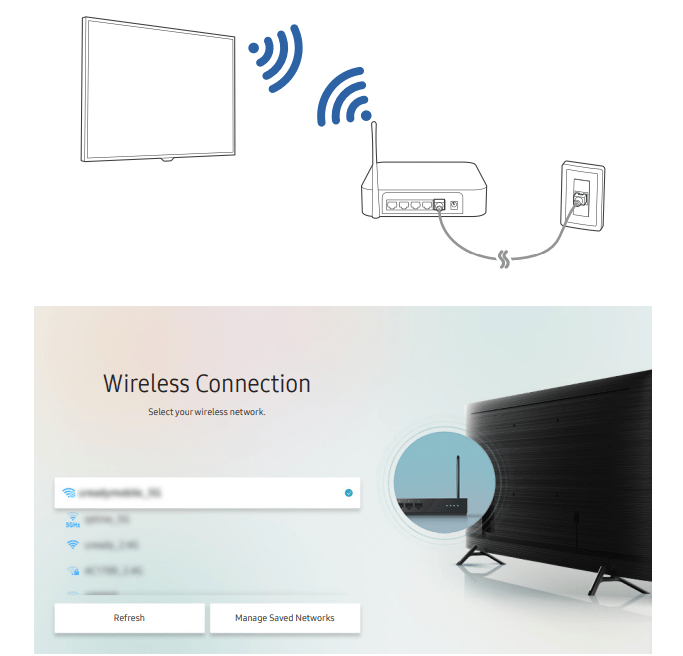
- The image on your TV may differ from the image above depending on the model and geographical area.
- If no wireless access point is found, select Add Network at the bottom of the list and enter the network name (SSID).
- If your wireless access point has a WPS or PBC button, select Use WPS at the bottom of the list, and then push the WPS or PBC button on your access point within 2 minutes. The TV will connect automatically.
- To view or delete previously connected network names (SSIDs), move the focus to Manage Saved Networks, and then press the Select button.
Checking the Internet connection status
 ->
-> Settings -> General -> Network -> Network Status
Settings -> General -> Network -> Network Status 
- View the current network and Internet status.
Resetting Your Network
 ->
-> Settings -> General -> Network -> Reset Network
Settings -> General -> Network -> Reset Network 
- Restore the network settings to the factory default.
Turning on the TV with a mobile device
 ->
->  Settings -> General -> Network -> Expert Settings -> Power On with Mobile
Settings -> General -> Network -> Expert Settings -> Power On with Mobile- You can turn on the TV using a mobile device connected to the same network as the TV. This function is available with a mobile device connected to the TV through the SmartThings app or the Apple AirPlay function.
Connecting an IP control device to the TV
 ->
->  Settings -> General -> Network -> Expert Settings -> IP Remote
Settings -> General -> Network -> Expert Settings -> IP Remote
You can connect an IP control device to the TV remotely to manage your IP device.
- To use this function, Power On with Mobile must be turned on.
- Turning this feature on may allow other IP control devices to control your TV. We recommend turning this feature on only if an authorized third-party custom controller is installed and configue specifically for a Samsung TV and if your Wi-Fi network is password protected.
- This function may not be supported depending on the model.
Changing the name of the TV
 ->
->  -> Settings -> General -> System Manager -> Device Name
-> Settings -> General -> System Manager -> Device Name 
- You can change the name of the TV on the network. Select User Input at the bottom of the list and change the name.
Remote Control and Peripherals
You can control TV operations with your Samsung Smart Remote. Pair external devices such as a keyboard for ease of use.
About the Samsung Smart Remote (QLED TV and The Serif)
Learn about the buttons on the Samsung Smart Remote that comes with the QLED TV (except for Q50R model) and The Serif
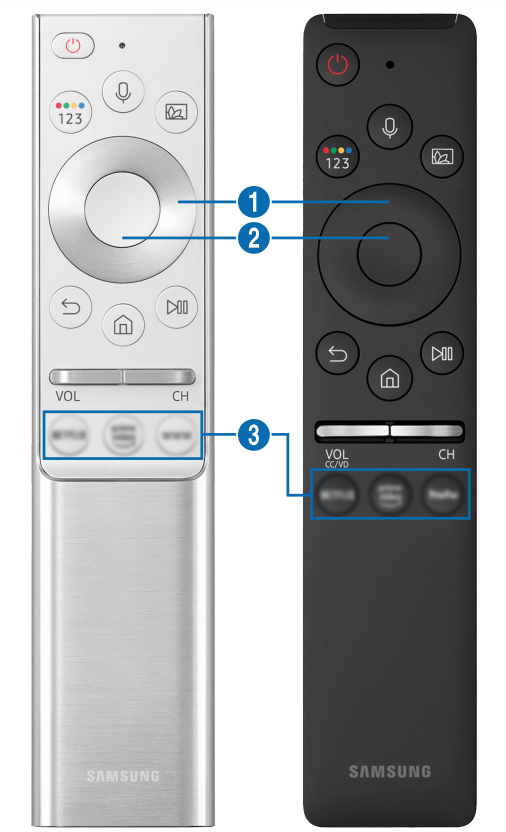
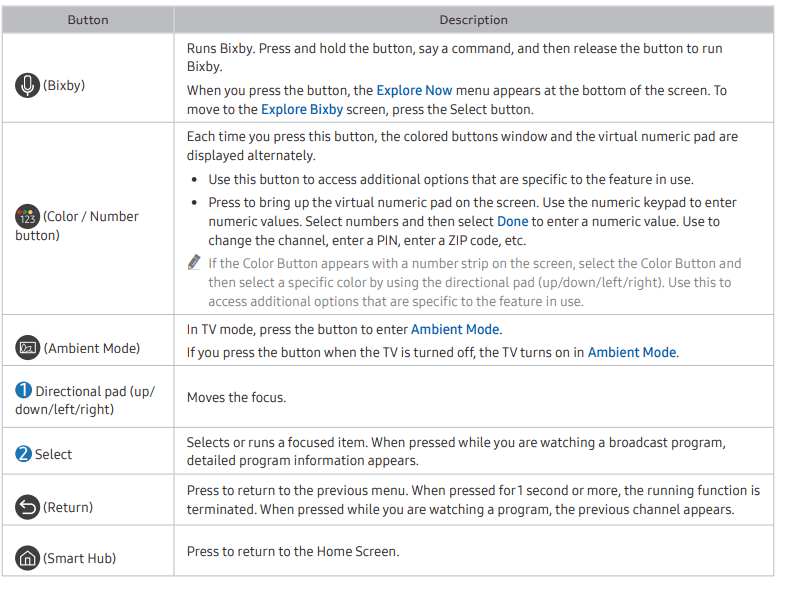

- Use the Samsung Smart Remote less than 20 feet (6 m) from the TV. The usable distance may vary with the wireless environmental conditions.
- The images, buttons, and functions of the Samsung Smart Remote may differ with the model or geographical area.
- The Samsung Smart Remote may not be supported depending on the model or geographical area.
- To use the Samsung Smart Remote to control a compatible external device that does not support HDMI-CEC (Anynet+), you must configure universal remote control for the device. For more information, refer to "Controlling External Devices with a Samsung Remote Control - Using the Universal Remote."
- To use the Samsung Smart Remote to control a compatible external device that does support HDMI-CEC (Anynet+), connect the device to an HDMI port on the TV using an HDMI cable. For more information, refer to "Using Anynet+ (HDMICEC)."
- For Q50R model, refer to "About the Samsung Smart Remote (UHD TV and Q50R model)."
About the Samsung Smart Remote (UHD TV and Q50R model)
Learn about the buttons on the Samsung Smart Remote that comes with the UHD TV and Q50R model.
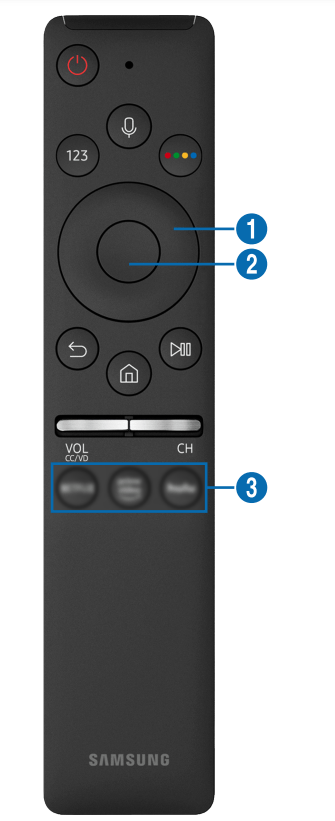
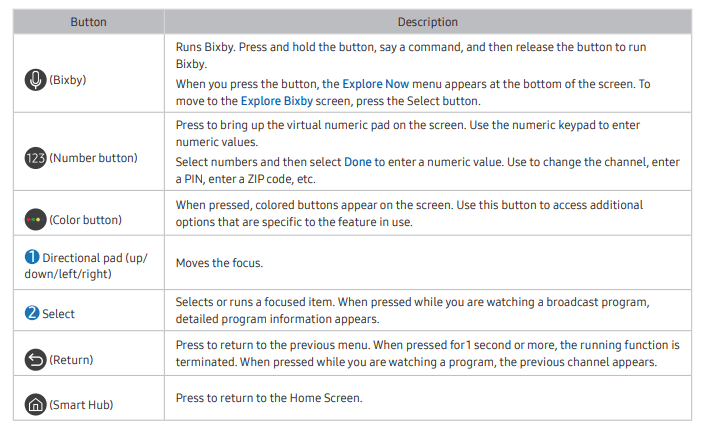

- Use the Samsung Smart Remote less than 20 feet (6 m) from the TV. The usable distance may vary with the wireless environmental conditions.
- The images, buttons, and functions of the Samsung Smart Remote may differ with the model or geographical area.
- The Samsung Smart Remote may not be supported depending on the model or geographical area.
- To use the Samsung Smart Remote to control a compatible external device that does not support HDMI-CEC (Anynet+), you must configure universal remote control for the device. For more information, refer to "Controlling External Devices with a Samsung Remote Control - Using the Universal Remote."
- To use the Samsung Smart Remote to control a compatible external device that does support HDMI-CEC (Anynet+), connect the device to an HDMI port on the TV using an HDMI cable. For more information, refer to "Using Anynet+ (HDMICEC)."
About the Samsung Smart Remote (The Frame)
Learn about the buttons on the Samsung Smart Remote that comes with the The Frame.

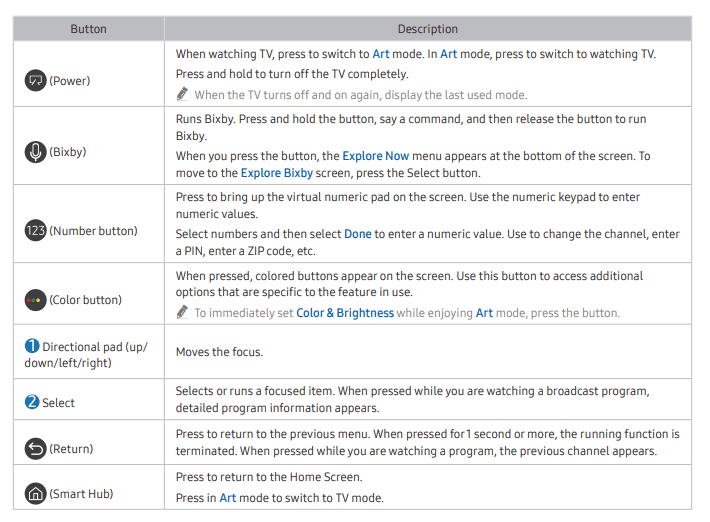

- Use the Samsung Smart Remote less than 20 feet (6 m) from the TV. The usable distance may vary with the wireless environmental conditions.
- The images, buttons, and functions of the Samsung Smart Remote may differ with the model or geographical area.
- The Samsung Smart Remote may not be supported depending on the model or geographical area.
- To use the Samsung Smart Remote to control a compatible external device that does not support HDMI-CEC (Anynet+), you must configure universal remote control for the device. For more information, refer to “Controlling External Devices with a Samsung Remote Control - Using the Universal Remote.”
- To use the Samsung Smart Remote to control a compatible external device that does support HDMI-CEC (Anynet+), connect the device to an HDMI port on the TV using an HDMI cable. For more information, refer to "Using Anynet+ (HDMICEC)."
Connecting to the Samsung Smart Remote
Pair the TV with the Samsung Smart Remote.
- When you turn on the TV for the first time, the Samsung Smart Remote pairs to the TV automatically. If the Samsung Smart Remote does not pair to the TV automatically, point it at the front of the TV, and then press and hold the
 and
and  buttons simultaneously for 3 seconds or more.
buttons simultaneously for 3 seconds or more.
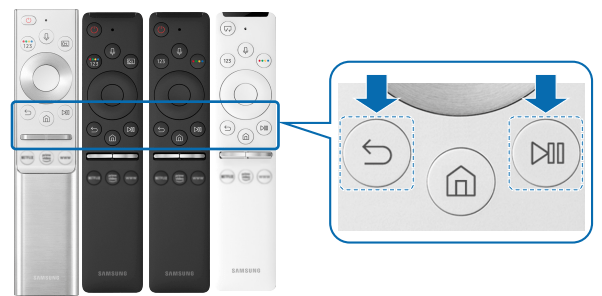
- The images, buttons, and functions of the Samsung Smart Remote may differ with the model or geographical area.
- The Samsung Smart Remote may not be supported depending on the model or geographical area.
Using Anynet+ (HDMI-CEC)
Control an external device connected via Anynet+ (HDMI-CEC) with the remote control.
You can use the TV's remote control to control external devices that are connected to the TV by an HDMI cable and that support Anynet+ (HDMI-CEC). Note that you can only set up and operate Anynet+ (HDMI-CEC) with the remote control.
Connecting an external device through Anynet+ and using their menus
 ->
->  Settings -> General -> External Device Manager -> Anynet+ (HDMI-CEC) Try Now
Settings -> General -> External Device Manager -> Anynet+ (HDMI-CEC) Try Now
- Set Anynet+ (HDMI-CEC) to On.
- Connect an HDMI-CEC-compliant device to the TV.
- Turn on the connected external device.
The device is automatically connected to the TV. After the connection process is finished, you can access the menu of the connected device using your TV remote and control the device.
The connecting process can take up to 2 minutes to complete.
Read before connecting an Anynet+ (HDMI-CEC) device
- Anynet+ (HDMI-CEC)-enabled devices must be connected to the TV with an HDMI cable. Note that some HDMI cables may not support Anynet+ (HDMI-CEC).
- You can cofigure the TV's Universal Remote to control third-party cable boxes, Blu-ray players, and home theaters that do not support HDMI-CEC. For more information, refer to "Controlling External Devices with a Samsung Remote Control - Using the Universal Remote."
- Anynet+ cannot be used to control external devices that do not support HDMI-CEC.
- The TV remote control may not work under certain circumstances. If this occurs, set up the device as an Anynet+ (HDMICEC)-enabled device again.
- Anynet+ (HDMI-CEC) works only with external devices that support HDMI-CEC, and only when those devices are either in standby mode or turned on. Anynet+ (HDMI-CEC) can control up to 12 compliant external devices (up to 3 of the same type) except for home theaters.
- Anynet+ (HDMI-CEC) can control only one home theater system.
- To listen to 5.1 channel audio from an external device, connect the device to the TV via an HDMI cable and connect a 5.1 home theater system directly to the external device's digital audio output connector.
- If an external device has been set up for both Anynet+ and a universal remote control, the device can be controlled only with the universal remote control.
Smart Features
You can enjoy various apps with Smart Hub.
Using Smart Hub
View descriptions of Smart Hub's basic functions. From Smart Hub, you can use the Internet search function, install and use various apps, view photos and videos, or listen to music stored on external storage devices, and perform more functions.
- Some Smart Hub services are paid services.
- To use Smart Hub, the TV must be connected to the Internet.
- Some Smart Hub features may not be supported depending on the service provider, language, or geographical area.
- Smart Hub service outages can be caused by disruptions in your Internet service.
- To use Smart Hub, you must agree to the Smart Hub service agreement and the collection and use of personal information. Without giving consent, you cannot use the additional features and services. You can view the entire text of the Terms & Privacy by navigating to
 ->
->  Settings -> Terms & Privacy. Try Now
Settings -> Terms & Privacy. Try Now - If you want to stop using Smart Hub, you can cancel the agreement. To cancel the Smart Hub service agreement, select Reset Smart Hub (
 ->
->  Settings -> Support -> Device Care -> Self Diagnosis -> Reset Smart Hub).
Settings -> Support -> Device Care -> Self Diagnosis -> Reset Smart Hub).
Displaying the Home Screen
Press the  button.
button.
On the Home Screen, you can easily run the apps you have used previously or frequently. The apps can also be moved or deleted from the screen.
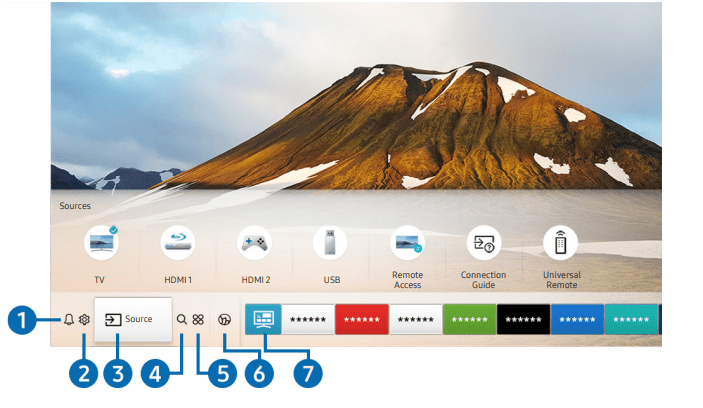
The image on your TV may differ from the image above depending on the model and geographical area.
On the Home Screen, you can easily run the apps you have used previously or frequently. The apps can also be moved or deleted from the screen.
1.  Notification: You can view a list of notifications for all events that occur on your TV. A notification appears on the screen when it is time to view a scheduled program or when an event occurs on a registered device. If you move the focus to Notification, and then press the Select button, a notification window appears on the right and the following functions are available:
Notification: You can view a list of notifications for all events that occur on your TV. A notification appears on the screen when it is time to view a scheduled program or when an event occurs on a registered device. If you move the focus to Notification, and then press the Select button, a notification window appears on the right and the following functions are available:
 Delete All You can delete all your notifications.
Delete All You can delete all your notifications. Settings
Settings- You can select services you want to be notified about.
- When you select Allow sound, notifications are displayed with a notification sound.
2.  Settings: When the focus is moved to Settings, a list of quick settings icons appears above the top of the menu. You can quickly set frequently used functions by clicking the icons.
Settings: When the focus is moved to Settings, a list of quick settings icons appears above the top of the menu. You can quickly set frequently used functions by clicking the icons.
- e-Manual: You can open the user manual embedded in your TV.
- Intelligent Mode: In Intelligent Mode, the TV recognizes and analyzes the surroundings, the content, and your usage patterns to provide the best viewing experience. To turn Intelligent Mode on or off, press the Select button. To set the detailed options, press the up directional button, and then select Intelligent Mode Settings.
- Because this function is specific to QLED TV (except for Q50R model), The Frame and The Serif, it may not be supported depending on the model.
- For more information about the Intelligent Mode, refer to "Using the Intelligent Mode."
- Picture Mode: You can select the picture mode that provides the best viewing experience. To change the picture mode, press the Select button. To make fi͝ʪ adjustments, press the up directional button, and then select Picture Setup.
- Sound Mode: You can select a sound mode to optimize your listening experience. To change the sound mode, press the Select button. To make fine adjustments, press the up directional button, and then select Equalizer Setup.
- Sound Output: You can select which speakers the TV uses for audio output. To change the audio output, press the Select button. To connect to a Bluetooth speaker, press the up directional button, and then select Bluetooth Speaker List. Connecting Bluetooth speaker may not be supported depending on the model or geographical area.
- Game Mode: You can set the Game Mode to optimize the TV screen for better gaming performance. To turn Game Mode on or off, press the Select button. To set the detailed options, press the up directional button, and then select Go to Game Mode Settings.
- For more information, refer to "Setting the Viewing Environment for External Devices."
- This function is only available when an external input source is being used.
- Caption: You can watch TV broadcasts with captions. To activate or deactivate the Caption function, press the Select button. To run Accessibility Shortcuts, press the up directional button, and then select Accessibility Shortcuts.
- Sleep Timer: You can turn off the TV automatically at a specific time. To change the sleep time, press the Select button. To set the specific time at which the TV turns off automatically, press the up directional button, and then select Set Up Off Timer.
- Network: You can view the current network and Internet status. Press the up directional button, and then select Network Status or Network Settings.
- Color Tone : You can select a color tone suitable for your viewing preferences. To change to a color tone that you want, press the Select button.
- Picture Clarity: You can optimize pictures that contain a lot of motions. To turn this function on or off, press the Select button. To set the detailed options, press the up directional button, and then select Picture Clarity Settings.
- Digital Output Audio Format: You can select an output format for digital audio. Note that the Dolby Digital+ option is only available via HDMI (eARC) for external devices that support the Dolby Digital+ format.
- The HDMI (ARC) port may support eARC in some models
- TV Device Manager: You can run TV Device Manager to view at a glance and easily optimize the CPU usage, memory usage, and the storage space of the TV.
- Pressing
 Settings displays all setting menus available.
Settings displays all setting menus available. - These functions may not be supported depending on the model or geographical area.
- Pressing
3.  Source
Source
- You can select an external device connected to the TV. For more information, refer to "Switching between external devices connected to the TV."
4.  Search: You can search for channels, programs, movie titles, and apps from Smart Hub.
Search: You can search for channels, programs, movie titles, and apps from Smart Hub.
- To use this feature, the TV must be connected to the Internet.
5.  Apps: You can enjoy a wide range of contents, including news, sports, weather, and games by installing the corresponding apps on your TV.
Apps: You can enjoy a wide range of contents, including news, sports, weather, and games by installing the corresponding apps on your TV.
- To use this feature, the TV must be connected to the Internet.
- For more information, refer to “Using the Apps Service.”
6 .  Ambient Mode: You can enhance your living space with decorative content that matches the surroundings or view essential realtime information such as weather, time, and news on the TV screen when you are not watching TV. To enter Ambient Mode, press the
Ambient Mode: You can enhance your living space with decorative content that matches the surroundings or view essential realtime information such as weather, time, and news on the TV screen when you are not watching TV. To enter Ambient Mode, press the  button. To return to the TV mode, press the
button. To return to the TV mode, press the  button. To shut off the TV, press the
button. To shut off the TV, press the  button. If you press the
button. If you press the  button when the TV is turned off, the TV turns on in Ambient Mode.
button when the TV is turned off, the TV turns on in Ambient Mode.
- If you use a remote control other than the Samsung Smart Remote, there may be restrictions to entering Ambient Mode.
- Because this function is specific to QLED TV (except for Q50R model) and The Serif, it may not be supported depending on the model.
- For more information about the Ambient Mode, refer to "Using the Ambient Mode."
7.  Universal Guide: Universal Guide is an app that allows you to search for and enjoy various content such as TV shows, dramas, and movies in one place. Universal Guide can recommend content tailored to your preferences.
Universal Guide: Universal Guide is an app that allows you to search for and enjoy various content such as TV shows, dramas, and movies in one place. Universal Guide can recommend content tailored to your preferences.
- For more information about Universal Guide, refer to “Using the Universal Guide App.”
- Images may look blurry depending on the service provider's circumstances. "
- This function may not be supported depending on the model or geographical area.
 Art: When you are not watching TV or when the TV is turned off, you can use the Art mode function to edit image content, such as artworks, or photos, or to display the content.
Art: When you are not watching TV or when the TV is turned off, you can use the Art mode function to edit image content, such as artworks, or photos, or to display the content.
- This function is supported only in The Frame.
- For more information, refer to the provided user manual.

8. Moving an item on the Home Screen: Move the focus to the app you want to move, press and hold the Select button on the remote control, and then select Move in option menu. Move the app to the desired position by pressing the left or right directional button, and then press the Select button. The selected app is moved on the Home screen.
9. Removing an item on the Home Screen: Move the focus to the app you want to delete, press and hold the Select button on the remote control, and then select Remove in option menu. The selected app is deleted.
- You can add the apps you want to use often to the Home Screen using Apps. To add your favorite apps to the Home Screen, refer to "Managing installed apps."
Launching Smart Hub automatically
 ->
->  Settings -> General -> Smart Features -> Autorun Smart Hub Try Now
Settings -> General -> Smart Features -> Autorun Smart Hub Try Now- When you set Autorun Smart Hub to on, the TV displays the Home Screen automatically when you turn the TV on. You can turn this function on or off. Press the Select button at the current menu.
Launching the last used app automatically
 ->
->  Settings -> General -> Smart Features -> Autorun Last App Try Now
Settings -> General -> Smart Features -> Autorun Last App Try Now- If Autorun Last App is set to on, the last used app is automatically run when you turn on the TV. You can turn this function on or off. Press the Select button at the current menu.
- This function may not be supported depending on the model.
Testing Smart Hub connections
 ->
->  Settings -> Support -> Device Care -> Self Diagnosis -> Smart Hub Connection Test Try Now
Settings -> Support -> Device Care -> Self Diagnosis -> Smart Hub Connection Test Try Now
Resetting Smart Hub
 ->
->  Settings -> Support -> Device Care -> Self Diagnosis -> Reset Smart Hub Try Now
Settings -> Support -> Device Care -> Self Diagnosis -> Reset Smart Hub Try Now
- You can reset the Smart Hub settings. To reset Smart Hub, enter the PIN. The default PIN is "0000." You can set the PIN in
 ->
->  Settings General System Manager Change PIN.
Settings General System Manager Change PIN. - Change PIN may not be supported depending on the model or geographical area.
Troubleshooting
Picture Issues
When the TV has trouble with the picture, these steps may help resolve the problem.
Testing the picture:  ->
->  Settings -> Support -> Self Diagnosis -> Start Picture Test Try Now
Settings -> Support -> Self Diagnosis -> Start Picture Test Try Now
Before you review the list of problems and solutions below, use Picture Test to determine if the problem is caused by the TV. Picture Test displays a high definition picture you can examine for flaws or faults.
1. Flickering and Dimming
If your TV is flickering or dimming sporadically, you may need to disable some of the energy ʪ˙efficiency features.
Disable Ambient Light Detection, Power Saving Mode, or Motion Lighting
 ->
->  Settings -> General -> Eco Solution -> Ambient Light Detection
Settings -> General -> Eco Solution -> Ambient Light Detection ->
->  Settings -> General -> Eco Solution -> Power Saving Mode
Settings -> General -> Eco Solution -> Power Saving Mode ->
->  Settings -> General -> Eco Solution -> Motion Lighting
Settings -> General -> Eco Solution -> Motion Lighting
2. Component Connections and Screen Color
- If the color on your TV screen is not correct or the black and white colors are off, run Start Picture Test.
 ->
->  Settings -> Support -> Self Diagnosis -> Start Picture Test.
Settings -> Support -> Self Diagnosis -> Start Picture Test.
If the test results indicate that the problem is not caused by the TV, do the following:
- When using the One Connect Box, confirm that its video input connectors are connected to the correct external device video output connectors.
- When using the component cable, confirm that the green (Y), blue (Pb), and red (Pr) jacks are plugged into their proper connectors.
- For more information about how to connect an external device, run Connection Guide.
 ->
->  Source ->Connection Guide
Source ->Connection Guide
3. Screen Brightness
If the colors on your TV are correct but just a little too dark or bright, try adjusting the following settings first
 ->
->  Settings -> Picture -> Expert Settings -> Backlight
Settings -> Picture -> Expert Settings -> Backlight ->
->  Settings -> Picture -> Expert Settings ->Contrast
Settings -> Picture -> Expert Settings ->Contrast ->
->  Settings -> Picture -> Expert Settings -> Brightness
Settings -> Picture -> Expert Settings -> Brightness ->
->  Settings -> Picture -> Expert Settings -> Sharpness
Settings -> Picture -> Expert Settings -> Sharpness ->
->  Settings -> Picture -> Expert Settings -> Color
Settings -> Picture -> Expert Settings -> Color ->
->  Settings -> Picture -> Expert Settings -> Tint (G/R)
Settings -> Picture -> Expert Settings -> Tint (G/R)
4. Blurring, or Juddering
If you notice blurring or juddering on the screen, use the Picture Clarity Settings function to resolve the issue.
 ->
->  Settings -> Picture -> Expert Settings ->Auto Motion Plus Settings
Settings -> Picture -> Expert Settings ->Auto Motion Plus Settings
5. Unwanted Powering Off
If your TV appears to turn off by itself, try disabling some of the TV's energy ʪ˙efficiency functions.
See if Sleep Timer has been enabled. The Sleep Timer automatically turns the TV off after a specified period of time.
 ->
->  Settings -> General -> System Manager -> Time -> Sleep Timer
Settings -> General -> System Manager -> Time -> Sleep Timer
If the Sleep Timer has not been enabled, see if Auto Power Off or Off Timer has been enabled and disable it.
 ->
->  Settings -> General -> Eco Solution -> Auto Power Off
Settings -> General -> Eco Solution -> Auto Power Off ->
->  Settings -> General -> System Manager -> Time -> Off Timer
Settings -> General -> System Manager -> Time -> Off Timer
6. Problems Powering On
- If you are having problems powering on your TV, there are a number of things to check before calling the service department.
- Confirm that the TV's power cord is connected correctly at both ends and that the remote control is operating normally.
- Make sure that the antenna cable or cable TV cable is firmly connected.
- If you have a cable box or satellite box, Confirm that it is plugged in and turned on.
7. Unable to find a Channel
- If your TV is not connected to a cable box or satellite box, run Auto Program.
 ->
->  Settings -> Broadcasting -> Auto Program
Settings -> Broadcasting -> Auto Program
8. The TV image does not look as good as it did in the store
- Store displays are tuned to a digital UHD channel or HD channel.
- Change the output resolution of your devices, such as digital broadcast receiver, IPTV, and set-top box to UHD or HD.
- Be sure to use an HDMI cable to enjoy high quality videos.
- To connect the TV with your PC, make sure that your PC's graphic card supports UHD resolutions.
- For more information about the supported UHD resolutions, refer to “Supported Resolutions for UHD Input Signals.”
9. The picture is distorted
- The compression of video content may cause picture distortions, especially in fast moving pictures from sports programs and action movies.
- If the signal reception is weak or poor, screen distortion may be visible but it is not a malfunction.
- Mobile phones used close to the TV (within 3.2 ft) may cause noise on analog and digital channels.
10. The color is wrong or missing
- If you’re using a Component connection, make sure that the Component cables are connected to the correct jacks.
- Incorrect or loose connections may cause color problems or a blank screen.
11. The color is poor or the picture is not bright enough
Go to Picture and then adjust the Picture Mode, Brightness, Sharpness, and Color settings.
 ->
->  Settings -> Picture -> Picture Mode
Settings -> Picture -> Picture Mode ->
->  Settings -> Picture -> Expert Settings -> Brightness
Settings -> Picture -> Expert Settings -> Brightness ->
->  Settings -> Picture -> Expert Settings -> Sharpness
Settings -> Picture -> Expert Settings -> Sharpness ->
->  Settings -> Picture -> Expert Settings -> Color
Settings -> Picture -> Expert Settings -> Color
See if Brightness Reduction has been enabled.
 ->
->  Settings -> General -> Eco Solution -> Power Saving Mode
Settings -> General -> Eco Solution -> Power Saving Mode
Try resetting the picture.
 ->
->  Settings -> Picture -> Expert Settings -> Reset Picture
Settings -> Picture -> Expert Settings -> Reset Picture
12. There is a dotted line on the edge of the screen
- Change Picture Size to 16:9 Standard.
 ->
->  Settings -> Picture -> Picture Size Settings → 16:9 Standard
Settings -> Picture -> Picture Size Settings → 16:9 Standard
13. The picture is black and white
- Use a composite cable when you connect AV equipment to the TV.
- If you are using the composite cable, connect the video cable (Yellow) to the VIDEO (Yellow / Green) input port.
- Check whether Grayscale is set to On.
 ->
->  Settings -> General -> Accessibility -> Grayscale
Settings -> General -> Accessibility -> Grayscale
14. The picture won’t display in full screen
- HD channels will have black bars on either side of the screen when displaying upscaled SD (4:3) content.
- Black bars will appear at the top and bottom of the screen when you watch movies that have aspect ratios different from your TV.
- Adjust the picture size options on your external device or set the TV to full screen.
 ->
->  Settings -> Picture -> Picture Size Settings -> Picture Size
Settings -> Picture -> Picture Size Settings -> Picture Size
15. The Caption function in the TV menu is deactivated
- When an external device is connected with an HDMI or Component cable, the Caption function is unavailable. Adjust the caption setting on the external device.
16. Captions appear on the TV screen
- Turn off the Caption function in Caption Settings.
 ->
->  General -> Accessibility → Caption Settings -> Caption
General -> Accessibility → Caption Settings -> Caption
If the test picture does not appear or there is noise or distortion, the TV may have a problem. Contact Samsung’s Call Center for assistance.
If the test picture is displayed properly, there may be a problem with an external device. Please check the connections.
If the problem persists, check the Signal Information or refer to the external device’s user manual
Sound and Noise Issues
When the TV has difficulties with sound, these steps may help resolve the problem.
Testing the sound
 ->
->  Settings -> Support -> Device Care -> Self Diagnosis -> Start Sound Test. If the TV plays the Sound Test melody without distortion, there may be a problem with an external device or the broadcast signal's strength.
Settings -> Support -> Device Care -> Self Diagnosis -> Start Sound Test. If the TV plays the Sound Test melody without distortion, there may be a problem with an external device or the broadcast signal's strength.
1. How can I connect an audio device to the TV?
- The connection method may differ depending on the audio device.
- For more information about how to connect an audio device, run Connection Guide.
 ->
->  Source -> Connection Guide -> Audio Device
Source -> Connection Guide -> Audio Device
2. There is no sound or the sound is too low at maximum volume
- Check the volume control of your TV, and then check the volume control of the external device (cable box or satellite box, DVD, Blu-ray, etc.) connected to your TV.
3. The picture is good but there is no sound.
- Set Sound Output to TV Speaker.
 ->
->  Settings -> Sound -> Sound Output
Settings -> Sound -> Sound Output - If you are using an external device, check the device’s audio output option.
- For example, you may need to change your cable box’s audio option to HDMI if the box connected to your TV is using an HDMI cable.
- To listen to computer sound, connect an external speaker to the computer’s audio output connector.
- If your TV has a headphone jack, make sure there is nothing plugged into it.
- Reboot the connected device by disconnecting and then reconnecting the device’s power cable.
4. No sound is heard.
- Check whether Digital Output Audio Format is set to Dolby Digital+.
- Set Digital Output Audio Format to Dolby Digital+ only when you play Dolby Digital+ (with Atmos) content.
- If you are using an AV receiver that does not support Dolby Digital+, you will hear no sound when you select Dolby Digital+..
 ->
->  Settings -> Sound -> Expert Settings -> Digital Output Audio Format -> Dolby Digital+
Settings -> Sound -> Expert Settings -> Digital Output Audio Format -> Dolby Digital+
5. The speakers are making an odd sound.
- Run Start Sound Test.
 ->
->  Settings -> Support -> Self Diagnosis -> Start Sound Test
Settings -> Support -> Self Diagnosis -> Start Sound Test - Make sure that the audio cable is connected to the correct audio output connector on the external device.
- For antenna or cable connections, check the Signal Information. A low signal level may cause sound distortions.
6. The sound is interrupted.
- The sound may frequently be interrupted when a Bluetooth speaker is used. Make sure that the Bluetooth speaker and the wireless access point are on a straight line, and the Bluetooth speaker is placed as close as possible to the TV.
- To minimize interruptions, we recommend a wireless access point that uses a 5 GHz frequency
- If the problem persists, we recommend that you use a wired connection.
7. Whenever a function is used on the TV or the channel is changed, the TV voices the activity. The TV explains in voice-over the video scenes displayed on the screen.
- Turn off the Voice Guide function in Voice Guide Settings.
 ->
->  Settings -> General -> Accessibility -> Voice Guide Settings -> Voice Guide
Settings -> General -> Accessibility -> Voice Guide Settings -> Voice Guide
8. The TV audio is not being played through the AV receiver.
- Make sure that the AV receiver is connected to the TV's HDMI (ARC) port with an HDMI cable.
- Confirm that the AV receiver is HDMI (ARC) compatible.
- If the AV receiver is not HDMI (ARC) compatible, connect the TV and the AV receiver with an optical cable. The HDMI (ARC) port may support eARC in some models.
Channel and Broadcast Issues
When the TV has difficulties receiving broadcasts, these steps may help resolve the problem.
1. "Weak or No Signal" displayed in TV mode or cannot find channel.
- Make sure that the external device is connected securely and turned on. Move to Sources to switch to other input sources.
 ->
->  Source -> Sources
Source -> Sources
2. The TV is not receiving all channels.
- Confirm that the coaxial cable is securely connected to the TV.
- Run Reset or Auto Program.
 ->
->  Settings -> General -> Reset.
Settings -> General -> Reset. ->
->  Settings -> Broadcasting -> Auto Program
Settings -> Broadcasting -> Auto Program
3. There are no captions with digital channels.
- Go to Caption Settings and turn on the Caption function, and then change the Caption Mode..
 ->
->  Settings -> General -> Accessibility -> Caption Settings
Settings -> General -> Accessibility -> Caption Settings - Some channels may not have caption data.
4. Broadcasting is deactivated.
- Broadcasting is only available when Source is set to TV.
- Broadcasting cannot be accessed while you watch TV using a cable box or satellite box.
- Broadcasting cannot be accessed while a recording is in progress or the Timeshift function is running.
External Device Connectivity Issues
When the TV has difficulties connecting to external devices such as a PC, game console, or mobile device, these steps may help resolve the problem.
1. The "Mode Not Supported" message appears.
- Adjust the output resolution of the external device to a resolution supported by the TV.
2. The video is OK but there is no audio.
- If you are using an HDMI connection, check the audio output setting on your PC.
- If you are using a DVI to HDMI cable, a separate audio cable is required.
- To listen to the computer sound, connect external speakers to the audio output connection of the computer.
3. How can I use Screen Mirroring?
- To wirelessly connect the TV to your PC, read the instructions at PC → Screen Sharing (Wireless) in Connection Guide, and then try to connect.
 ->
->  Source -> Connection Guide -> PC -> Screen Sharing (Wireless)
Source -> Connection Guide -> PC -> Screen Sharing (Wireless) - Confirm that the TV and your PC are connected to the same network.
- To wirelessly connect the TV to your mobile device, read the instructions at Smartphone Screen Sharing (Smart View) in Connection Guide, and then try to connect.
 ->
->  Source -> Connection Guide -> Smartphone -> Screen Sharing (Smart View)
Source -> Connection Guide -> Smartphone -> Screen Sharing (Smart View) - If the TV has difficulties connecting to your PC or mobile device due to surrounding radio interferences, change the frequency of the wireless access band, and then try to connect.
4. No screen appears when connecting the TV to an external device.
- For more information about how to connect an external device, run Connection Guide.
 ->
->  Source -> Connection Guide
Source -> Connection Guide - Make sure that the external device is connected securely and turned on. Move to Sources to switch to other input sources.
 ->
->  Source -> Sources
Source -> Sources
Network Issues
When the TV has difficulties connecting to the Internet, these steps may help resolve the problem.
 ->
->  Settings -> Support -> Self Diagnosis -> Start Smart Hub Connection Test Try Now Try Now
Settings -> Support -> Self Diagnosis -> Start Smart Hub Connection Test Try Now Try Now
If the TV has trouble with network connection or TV services, check the Smart Hub connection status.
1. Wireless network connection failed. Unable to connect to a wireless access point.
- Make sure that no items that can generate electromagnetic interferences are placed between the TV and the wireless/wired access point.
- Check if the access point is turned on. If it is on, turn it off, wait 1 or 2 minutes, and then turn it on.
- Enter the correct password if required.
- If the wireless connection fails, connect the TV to the access point via a LAN cable.
- If the TV can connect to the Internet normally via the wired connection, there might be a problem with the access point. In this case, try using a different access point.
2. Wired network connection failed.
- Check if the LAN cable is plugged in on both ends. If it is plugged in, check if the access point is turned on. If it is on, turn it off, wait 1 or 2 minutes, and then turn it on.
3. Auto IP configuration failed. Unable to connect to the network.
- Check if the LAN cable is plugged in on both ends.
- If it is plugged in, check if the access point is turned on. If the access point is on, turn it off, wait 1 or 2 minutes, and then turn it on.
- Disconnect and then reconnect the power cable of the TV, or press and hold the power button for 3 seconds.
4. Connected to a local network, but not to the Internet.
- Check if the Internet LAN cable is connected to the access point's external LAN port.
- Check the DNS setting in IP Settings. –
 ->
->  Settings -> General -> Network -> Network Status -> IP Settings
Settings -> General -> Network -> Network Status -> IP Settings
5. Network setup is completed, but unable to connect to the Internet.
- If the problem persists, contact your Internet service provider.
Wired networks are not supported by some models.
Anynet+ (HDMI-CEC) Issues
When Anynet+ (HDMI-CEC) isn't working, these steps may help resolve the problem.
1. What is Anynet+?
- You can use the TV's remote control to control external devices that support Anynet+ (HDMI-CEC) and that are connected to the TV via an HDMI cable. For example, if a connected external device supports Anynet+, you can have the connected device turn on or off when you turn the TV on or off.
2. Anynet+ does not work.
- Confirm that the device is an Anynet+ device. The Anynet+ system supports Anynet+ devices only. Check if the power cord of the Anynet+ device is properly connected.
- Check the cable connections of the Anynet+ device.
- Go to Anynet+ (HDMI-CEC) and see if Anynet+ (HDMI-CEC) has been set to On.
 ->
->  Settings -> General -> External Device Manager → Anynet+ (HDMI-CEC)
Settings -> General -> External Device Manager → Anynet+ (HDMI-CEC) - Anynet+ (HDMI-CEC) Anynet+ may not function when some other functions are active, including Channel Search, Smart Hub, Initial Setup, etc.
- If you have disconnected and then reconnected the HDMI cable, scan for devices again or turn your TV off and on.
3. I want to start Anynet+. I also want the connected devices to turn on when the TV is turned on.
- Move the focus to the Anynet+ device at
 ->
->  Source, press the up directional button to move to Anynet+ (HDMI-CEC), and then press the Select button.
Source, press the up directional button to move to Anynet+ (HDMI-CEC), and then press the Select button. - Check if the Anynet+ device is properly connected to the TV, and then select Anynet+ (HDMI-CEC) menu to see if Anynet+ (HDMI-CEC) is set to On.
 ->
->  Settings -> General -> External Device -> Manager Anynet+ (HDMI-CEC)
Settings -> General -> External Device -> Manager Anynet+ (HDMI-CEC)
4. I want to exit Anynet+. I also do not want the connected devices to turn on and off when the TV is turned on or off.
- Turn off the Anynet+ (HDMI-CEC) function..
 ->
->  Settings -> General -> External Device Manager -> Anynet+ (HDMI-CEC)
Settings -> General -> External Device Manager -> Anynet+ (HDMI-CEC)
5. The message "Connecting to Anynet+ device..." or "Disconnecting from Anynet+ device" appears on the screen.
- You cannot use the remote control when the TV is configuring Anynet+ or switching to the TV viewing screen.
- Use the remote control after the TV has completed the Anynet+ configuring or has switched to the TV viewing screen.
6. The Anynet+ device won't play.
- You cannot use the play function when Reset is in progress.
7. The connected device is not displayed.
- Check whether the device supports Anynet+.
- Anynet+ devices must be connected to the TV using an HDMI cable. Make sure the device is connected to your TV with an HDMI cable. Some HDMI cables may not support Anynet+.
- Check whether the HDMI cable is properly connected.
- Go to Anynet+ (HDMI-CEC) and see if Anynet+ (HDMI-CEC) has been set to On.
 ->
->  Settings -> General -> External Device Manager -> Anynet+ (HDMI-CEC)
Settings -> General -> External Device Manager -> Anynet+ (HDMI-CEC) - Scan for Anynet+ devices again.
- If the connection is terminated because there has been a power failure or the HDMI cable has been disconnected, please scan for the device again.
Remote Control Issues
When the remote control isn't working, these steps may help resolve the problem
1. The remote control does not work.
- The connection between the Samsung Smart Remote and the TV may be lost. Point the Samsung Smart Remote at the front of the TV, and then press and hold the
 and
and  buttons simultaneously for 3 seconds or more. Also, if the remote control is not working or slow, the batteries might be low or dead. If this is the case, replace the batteries. Alkaline batteries are recommended for longer battery life
buttons simultaneously for 3 seconds or more. Also, if the remote control is not working or slow, the batteries might be low or dead. If this is the case, replace the batteries. Alkaline batteries are recommended for longer battery life
2. The remote control batteries run out quickly
- The batteries may be consumed quickly if the remote control is used very frequently or the Voice Wake-up function is turned on.
- You can extend the battery life by turning off the Voice Wake-up function.
 → Explore Now →
→ Explore Now →  Settings → Voice Wake-up
Settings → Voice Wake-up
Recording Issues
When Timeshift or Schedule recording aren't working, these steps may help resolve the problem.
- The Timeshift or recording function cannot be used.
- Check if there is a storage device connected to the TV.
- Recording will automatically stop if the signal becomes too weak.
- Check the free space on the storage device.
- The function will not work if there isn't enough storage space on the USB device.
- Before using the recording function, be sure to read all precautions. For more information, refer to "Before Using the Recording and Timeshift Functions."
2. Cannot record videos received from an external device or Samsung TV Plus.
- The recording function is only available for digital broadcast channels received by the TV. You cannot record videos received from an external device or Samsung TV Plus.
3. The "Format Device" message appears when the Timeshift or recording function is used.
- To use the recording function, the storage device connected to the TV must have been already formatted.
- Formatting the storage device deletes all data from it, and the storage device is formatted in NTFS.
4. The recorded files on the TV are not played back on a PC.
- The recorded files on the TV can only be played back on the same TV. Those video files cannot be played back on a PC or other TV.
Apps
When apps aren't working, these steps may help resolve the problem.
1. I launched an app, but it's in a different language. How can I change the language?
- Languages supported by an app may be different from the TV Language set in the menu.
- The ability to change the language depends on the app's provider.
2. My application is not working.
- The services of your application are not provided by the TV but by the application service provider.
- Refer to the Help section on the application service provider's website.
Media Files
When files don't play, this may help resolve the problem
1. Some files are interrupted during playback.
- This problem may occur with unsupported files or high-bitrate files. Most files can be played back, but some file may not play smoothly.
2. Some files can't be played.
- Some files that use an unsupported codec may not be played back.
- Make sure that the codec is supported by the TV. For more information, refer to "Read Before Playing Photo, Video, or Music Files."
Voice Assistant Issues
When the Voice Assistant isn't working, these steps may help resolve the problem.
- The Voice Wake-up function may not be supported depending on the model or geographical area.
1. Bixby answers automatically
- The TV may recognize an ambient noise or everyday conversation as a call to Bixby.
- Turn off the Voice Wake-up function or set the sensitivity to Low.
 → Explore Now →
→ Explore Now →  Settings → Voice Wake-up
Settings → Voice Wake-up
2. I spoke "Hi, Bixby" but Bixby does not answer.
The Samsung Smart Remote may not recognize your voice when it is far away from you, turned upside down, or located in an environment with loud ambient noise.
- Use the Samsung Smart Remote less than 2 feet (1.5 m) with the remote control buttons facing upward. (There is a built-in microphone on the front of the Samsung Smart Remote.)
- Do not place the Samsung Smart Remote near the TV speaker or an audio speaker.
Turn on the Voice Wake-up function.
 → Explore Now →
→ Explore Now →  Settings → Voice Wake-up
Settings → Voice Wake-up
Other issues
Use these procedures to resolve other issues that may occur in relation to the product.
1. The TV is hot.
- Watching TV for an extended period of time causes the panel to generate heat.
- The heat from the panel is dissipated through internal vents running along the top of the TV.
- The bottom, however, may feel hot to the touch after extended use.
- Children watching TV need constant adult supervision to prevent them from touching the TV.
- This heat, however, is not a defect and does not affect the TV's functionality.
2. The TV smells like plastic.
- This smell is normal and will dissipate over time.
3. The settings are lost after 5 minutes or every time the TV is turned off.
- If Usage Mode is set to Retail Mode, the TV's audio and video settings are automatically reset every 5 minutes.
- Change Usage Mode to Home Mode.
 ->
->  Settings -> General -> System Manager -> Usage Mode
Settings -> General -> System Manager -> Usage Mode
4. The TV is tilted to the side.
- Remove the base stand from the TV and reassemble it.
5. The stand is wobbly or crooked.
- Refer to the Quick Setup Guide and make sure that the stand is assembled correctly.
6. PIP is not available.
- PIP is available only when an external device is connected with an HDMI or Component cable.
- Note that the function is unavailable when Smart Hub is active.
- This function may not be supported depending on the model or geographical area.
7. A POP (TV’s internal banner ad) appears on the screen.
- Change Usage Mode to Home Mode.
 ->
->  Settings -> General -> System Manager -> Usage Mode
Settings -> General -> System Manager -> Usage Mode
8. The TV is making a popping noise.
- The expansion and contraction of the TV's outer casing may cause a popping noise.
- This does not indicate a product malfunction.
- The TV is safe to use.
9. The TV is making a humming noise.
- Your TV utilizes high-speed switching circuits and high levels of electrical current. Depending on the TV's brightness level, the TV may seem slightly noisier than a conventional TV.
- Your TV has undergone strict quality control procedures that meet our demanding performance and reliability requirements.
- Some noise coming from the TV is considered normal and is not an acceptable cause for an exchange or refund.
10. The software update over the Internet has failed.
- Check the network connection status.
 ->
->  Settings -> General -> Network -> Network Status
Settings -> General -> Network -> Network Status - If the TV is not connected to a network, connect it to a network.
- The upgrade stops if you already have the latest software version.
Diagnosing TV operational issues
You can diagnose issues with your TV and Smart Hub and run reset functions.
 ->
->  Settings -> Support -> Self Diagnosis Try Now
Settings -> Support -> Self Diagnosis Try Now
You can use the Picture Test to help diagnose video issues and the Sound Test to diagnose sound issues. You can also view signal strength information for over-the-air digital signals, test the Smart Hub Internet connection, and run the Smart Hub and TV factory reset functions.
- Start Picture Test
- Start Sound Test
- Start Signal Information
- TV Device Manager
- Smart Hub Connection Test
- Reset Smart Hub
1. Cannot select Signal Information in Self Diagnosis.
- Verify that the current channel is a digital channel.
- Signal Information is only available for digital channels.
 ->
->  Settings -> Support -> Self Diagnosis -> Signal Information
Settings -> Support -> Self Diagnosis -> Signal Information
2. Reset Smart Hub
- Resets all Smart Hub settings to their factory defaults and deletes all information related to Samsung accounts, linked service accounts, Smart Hub service agreements, and Smart Hub applications.
 ->
->  Settings -> Support -> Self Diagnosis -> Reset Smart Hub
Settings -> Support -> Self Diagnosis -> Reset Smart Hub
3. Reset picture
- Resets current picture settings to the default settings.
 ->
->  Settings -> Picture -> Expert Settings -> Reset Picture
Settings -> Picture -> Expert Settings -> Reset Picture
4. Reset sound
- Resets current sound settings to the default settings.
 ->
->  Settings -> Sound -> Expert Settings -> Reset Sound
Settings -> Sound -> Expert Settings -> Reset Sound
Getting Support
Get help directly from Samsung if you have a problem with your TV.
Getting support through Remote Management
 ->
->  Settings -> Support -> Remote Management Try Now
Settings -> Support -> Remote Management Try Now- After consenting to our service agreement, you can use Remote Management to access Remote Support and have a Samsung service technician diagnose your TV, correct problems, and update your TV's software remotely via the web. You can also turn Remote Management on and off. You can also start this function by pressing and holding
 the button for 5 or more seconds.
the button for 5 or more seconds.- This function requires an Internet connection.
Finding the contact information for service
 ->
->  Settings -> Support -> About TV Try Now
Settings -> Support -> About TV Try Now- You can view the address of the Samsung website, the call center phone number, your TV's model number, your TV's software version, Open Source License and other information you may need to get service support from a Samsung call agent or the Samsung website.
- You can also view information by scanning the QR code of your TV.
- You can also start this function by pressing and holding the
 button for 5 or more seconds. For the standard remote control, press and hold the
button for 5 or more seconds. For the standard remote control, press and hold the  (Play) button for 5 or more seconds. Continue holding the button until the customer information pop-up window appears.
(Play) button for 5 or more seconds. Continue holding the button until the customer information pop-up window appears.
Requesting service
 ->
->  Settings -> Support -> Device Care -> Request Support Try Now
Settings -> Support -> Device Care -> Request Support Try Now- You can request service when you encounter a problem with the TV. Select the item matching the problem that you encountered, enter the required item, move the focus to Next, and then press the Select button. Select Request Now -> Send or Schedule Appointment -> Request -> Send. Your service request will be registered. The Samsung Contact Center will contact you to set up or confirm your service appointment. You must agree to the terms and conditions for the service request. This function may not be supported depending on the geographical area. This function requires an Internet connection.
Caring for the TV
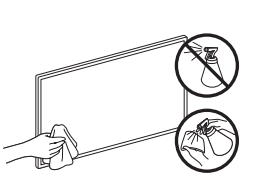
- If a sticker was attached to the TV screen, some debris can remain after you remove the sticker. Please clean the debris off before watching TV.
- The exterior and screen of the TV can get scratched during cleaning. Be sure to wipe the exterior and screen carefully using a soft cloth to prevent scratches.
- Do not spray water or any liquid directly onto the TV. Any liquid that goes into the product may cause a failure, fire, or electric shock.
- To clean the screen, turn off the TV, then gently wipe away smudges and fingerprints on the panel with a micro-fiber cloth. Clean the body or panel of the TV with a micro-fiber cloth dampened with a small amount of water. After that, remove the moisture with a dry cloth. While cleaning, do not apply strong force to the surface of the panel because it can damage the panel. Never use flammable liquids (benzene, thinner, etc.) or a cleaning agent. For stubborn smudges, spray a small amount of screen cleaner on a micro-fiber cloth, and then use the cloth to wipe away the smudges.
See other models: SM-T560NZKUXAC SM-A715FZKDXSA LU32J590UQEXXY LC27R500FHEXXY SM-R810NZDAXAC
